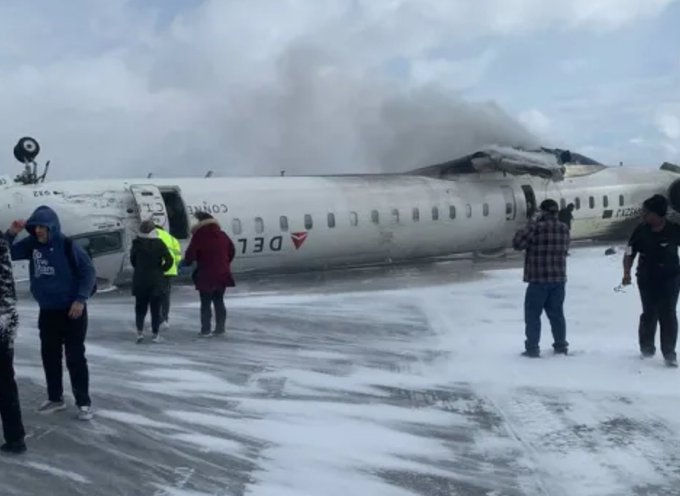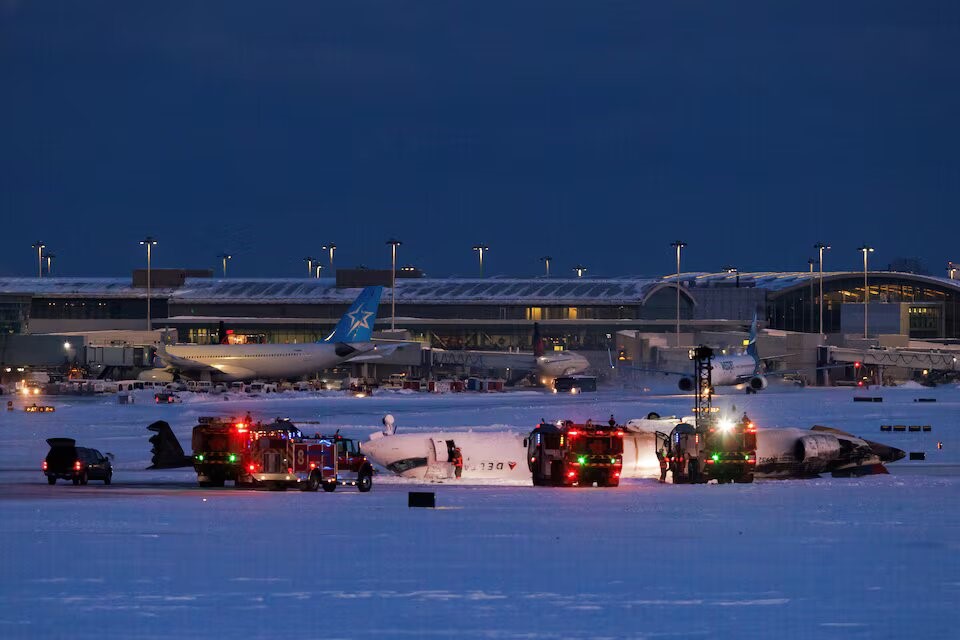TORONTO — A Delta Air Lines regional jet flipped upside down upon landing at Canada’s Toronto Pearson Airport this afternoon amid windy weather following a snowstorm, injuring 18 of the 80 people on board.
Three people on the flight that originated at Minneapolis-St. Paul International Airport suffered critical injuries, among them a child, authorities added.
U.S. carrier Delta said a CRJ900 aircraft operated by its Endeavor Air subsidiary was involved in a single-aircraft accident with 76 passengers and four crew members on board. The 16-year-old CRJ900, made by Canada’s Bombardier and powered by GE Aerospace engines, can seat up to 90 people.
The airport confirmed on X that an “incident” occurred with the Delta flight from Minneapolis and that all passengers and crew are accounted for. One passenger is critically injured and seven others were also hurt, paramedics said.
Video from the scene showed the plane upside down on the snowy tarmac as emergency workers hose it down. The plane was somewhat obscured by snow from a winter storm that hit Toronto over the weekend.
“Emergency teams are responding,” the airport said in a post on the social platform X. “All passengers and crew are accounted for.”

Delta said in a statement it was “aware of reports of Endeavor Flight 4819 operating from Minneapolis/St. Paul to Toronto-Pearson International Airport as involved in an incident.”
The plane, which was arriving from Minneapolis, has been photographed as lying on its roof without its wings on the tarmac.
Ontario’s Premier Doug Ford said on X he is “relieved there are no casualties after the incident at Toronto Pearson.”
“Provincial officials are in contact with the airport and local authorities and will provide any help that’s needed,” Ford said.
The airport said all passengers and crew are accounted for.
Data from Flightradar24 shows an Ornge Air ambulance helicopter landing at the airport.
No other data has been released on potential casualties or what caused the plane, a Delta CRJ900, to flip. Although crosswinds of up to 40 miles per hour are suspected.
Canadian authorities said they would investigate the cause of the crash, which was not yet known.
Passenger John Nelson posted a video of the aftermath on Facebook, showing a fire engine spraying water on the plane that was lying belly-up on the snow-covered tarmac.
He later told CNN there was no indication of anything unusual before landing.

“We hit the ground, and we were sideways, and then we were upside down,” Nelson told the television network.
“I was able to just unbuckle and sort of fall and push myself to the ground. And then some people were kind of hanging and needed some help being helped down, and others were able to get down on their own,” he said.
Pearson Airport said earlier today it was dealing with high winds and frigid temperatures as airlines attempted to catch up with missed flights after a weekend snowstorm dumped more than 8.6 inches (22 centimeters) of snow at the airport.
The Delta plane touched down in Toronto at 2:13 p.m. (1913 GMT) after an 86-minute flight and came to rest near the intersection of runway 23 and runway 15, according to flight tracking website FlightRadar24.
“The aircraft is upside down and burning,” an emergency worker told the air traffic control tower after a controller noted that some passengers were walking near the crashed plane, according to a recording of the incident posted on liveatc.net.
Deborah Flint, president of the Toronto airport, attributed to the absence of fatalities in part to the work of first responders at the airport.
“We are very grateful that there is no loss of life and relatively minor injuries,” she said at a press conference.
Michael J. McCormick, associate professor of air traffic management at Embry-Riddle Aeronautical University, said the upside-down position made the crash fairly unique.
“But the fact that 80 people survived an event like this is a testament to the engineering and the technology, the regulatory background that would go into creating a system where somebody can actually survive something that not too long ago would have been fatal,” he said.

Emergency responders operate around a plane on a runway after a plane crash at Toronto Pearson International Airport in Mississauga, Ontario, Canada February 17, 2025. REUTERS/Cole Burston
Airport delays
All 18 of the people injured were passengers and were taken to area hospitals, Delta said in a statement.
Of those injured, two were airlifted to trauma centers, and a child was transported to a children’s hospital, said Supervisor Lawrence Saindon of Peel Regional Paramedic Services.
The Toronto airport was shut down for more than two hours before departures and arrivals resumed. This led to ground delays and diversions to other airports including Montreal-Trudeau International Airport, which said it was preparing to receive several diverted flights that might cause further delays.
Flint said this evening there would be some operational impact and delays at Toronto airport over the next few days while two runways remained closed for the investigation.
The Transportation Safety Board of Canada (TSB) said it was deploying a team of investigators, and the U.S. National Transportation Safety Board said a team of investigators would assist Canada’s TSB.
Japan’s Mitsubishi Heavy Industries, which closed a deal to buy the CRJ aircraft program from Bombardier in 2020, said it was aware of the incident and would fully cooperate with the investigation.
The crash in Canada followed other recent crashes in North America. An Army helicopter collided with a CRJ-700 passenger jet in Washington, killing 67 people, while at least seven people died when a medical transport plane crashed in Philadelphia and 10 were killed in a passenger plane crash in Alaska.
Toronto is the capital of Ontario’s province.



